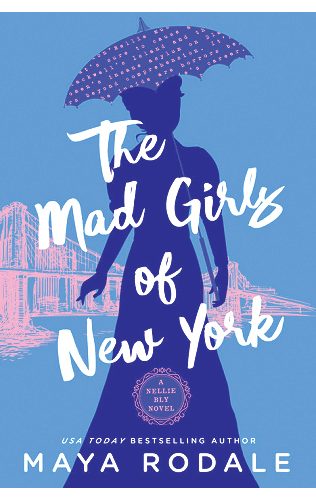Editor’s Note: We are fortunate to have two book reviewers for the Observer, and we will feature their reviews as we receive them.
Below is Carol Martin’s book review.

The Mad Girls of New York by Mya Rodale. Berkly April 2022.
Nellie Bly, who had decided to take that name for herself, had come to New York City to become a reporter, and as it turned out, that was not going to happen. Editors only wanted men reporters, and she could not even get an interview. Nellie could not be stopped however and dragged herself in on the coattails of a man who did have an interview and made a deal with the editor. She would get herself into the notorious Blackwell’s Island insane asylum and come out with a scoop for his paper.
That almost turned out to be her undoing, as it was a lot easier getting in than out. Situated on the East River, if you escaped out the door you ended up in the river. Also, if you entered with a small problem it became much worse, and you might never come out. The conditions were unbelievably grim. It’s definitely not a “beach read”. But then there are no comfortable beaches to read on, and it is an interesting book and different.
Below is Jane Shipp’s Book Review.

The Story Teller’s Secret
This book was interesting in many ways. As in so many current novels, there were two plots running along simultaneously: the story of Jaya, the narrator, who has been unable to conceive a child and has consequently distanced herself from her husband; and her grandmother in India, Amisha, who is deceased. Between the two generations is Jaya’s mother and Amisha’s daughter, Lena. The story revolves around Jaya’s visit to India to uncover her mother’s past. The book gives the reader a strong and colorful picture of rural India in the 1940s, during the British Raj—a subject most of us know about only from history books and only superficially. For that reason, it is well worth reading.
Jaya is determined to unearth the secret of her mother’s reluctance to have anything to do with her heritage. While in her mother’s home village, she explores her own marital situation. She explores it endlessly, repetitively, and in a sort of reportorial style with philosophical musings on her own fate. Her ongoing anguish, dropped into the story line again and again, becomes a bit tedious.
Although the writing is perfectly acceptable, it is not fluid. The dialogue is awkward, often with current American idioms in the mouths of the Indian villagers whom Jaya meets. Somehow the characters, to this reader, are not convincing. Maybe it’s all too “pat,” the good guys and the bad guys. The Brits who are occupying India don’t come off well, of course, and the details of Amisha’s death, brought about by her husband, are particularly gruesome. Jaya’s own awakening and resolution are somehow predictable and a bit too tidy.
Despite these flaws, the book can certainly be recommended for its picture of a time in Indian history which was pivotal. Much of the action takes place during World War II, after which India finally achieved its independence. The treatment of local people by their British masters, determined to “help” a culture different from their own, is wrenching. Amisha is caught between the two–as have other people been in other times of occupation in other countries.
The author of this book will be interviewed in our library’s Zoom program in May; details will be available on the library’s website.